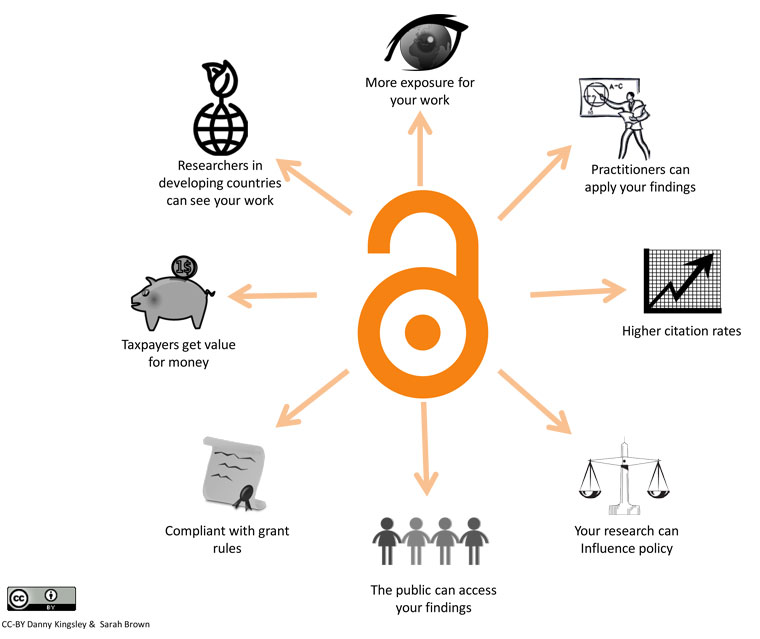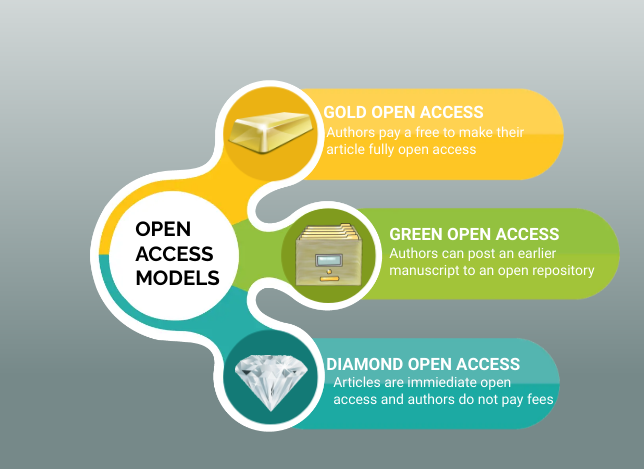8
Emily Bongiovanni
This chapter will help you:
- Recognize the main academic publishing models
- Navigate through the publishing process of a scholarly work
- Identify publishing models for your work
Introduction
The models for academic publishing have changed dramatically over the last few decades. When the print model moved to the online environment and large publishers took over small society journals, academic research became increasingly more expensive to access. New models have emerged in response to this changing publishing landscape.
Understanding the types of publishing
There are various types of outlet for research and scholarly communication, with ranging levels of rigor and processes. These include self-publication, grey literature, and scholarly publishing. Scholarly publishing refers to works published in an academic (or scholarly) journal or conference. These scholarly journals contain articles written by experts or researchers in the field and the content has undergone a rigorous peer-review process.
Scholarly publishing is typically viewed as the high standard for disseminating research, however other outlets may be appropriate for certain types of publications. For example, grey literature includes industry or government agency reports. While this type of literature does not have the same level of review as scholarly publications, they are typically considered authoritative sources of information. Self-publication is typically the fastest, but least rigorous of publishing methods. Self-publication includes blogs or social media posts and self-published books. There is typically very little to no formal review process in place for the content.
|
Self-Publication |
Grey Literature |
Scholarly Publishing |
|
|
|
Scholarly Journal Distribution Models
Reader access to journal content depends on the journal’s distribution model. The broad types of journals are traditional, Open Access, and hybrid. There are peer-reviewed journals in each of these models, however the access and distribution of these journals differ.
Traditionally, authors will transfer the rights to their works to the publisher and the publisher will charge readers to access the content. These journals use a subscription model for universities and institutions to pay for access to the journal’s content. In this subscription model, large publishers will offer bundles of journals at different costs to the university. These subscription costs are extremely expensive and many libraries struggle to maintain paying these subscriptions. Open Access publishing has emerged as a solution to these extreme costs.
|
Traditional |
Open Access |
Hybrid |
|
|
|
Open Access Publishing
Open Access (OA) publishing is relatively new, having just emerged within the last few decades. OA is different from traditional scholarly publishing models as the content is free for readers to access. There are many benefits to Open Access publishing by providing immediate and free access to academic scholarship. For example, free unrestricted access means all can benefit from the research, compared to just those who work at an institution that pays for access or who can afford it themselves. In addition, the increase in visibility can increase the citations and impact of the work.

Even though OA articles may be freely available to read, there may be costs to the authors to make their work open depending on the journal’s model. There are three main types of OA publishing: Gold OA, Green OA and Diamond (or Platinum) OA.

Gold Open Access
The Gold Open Access route makes the final publication fully open on through the publisher. This can be either in a full open access journal or in a hybrid journal. In this model, the author may be required to pay article processing charges (APC). These APCs are sometimes partially or fully covered by the author’s institution or the research funding agency. The Gold Open Access route allows authors to retrain copyright.
Green Open Access
Green Open Access is also referred to as self-archiving. In the Green OA route authors are able to post an earlier manuscript to an open repository, however the final published version is closed-access. In this model, the author usually transfers the copyright to the journal.
Diamond Open Access
In the Diamond, or Platinum, Open Access model, papers are immediately published as Open Access and there is no APC for the authors. Authors usually retain copyright of their work in this model.
See the Open Access Glossary at the end of the chapter for an overview of other OA models.
Scholarly Publishing Process
The steps to publishing in a scholarly journal include 1) selecting a journal, 2) preparing the paper, 3) submitting the paper, 4) peer review, 5) responding to peer reviews, 6) signing a copyright agreement if applicable, and 7) performing the final edits and review.

Step 1 – Selecting a journal
When selecting a journal, look for journals that publish similar research. Explore the journal’s website to better understand its scope. When selecting a journal, you may consider journal level-metrics or its copyright and open access policies.
Step 2 – Preparing the paper
Prepare your manuscript to the journal’s format and style requirements. These formatting and submission requirements are usually under the “For Authors” page or section of a journal’s website. The journal’s website should also indicate the type of peer-review model it uses and if the manuscript should be blinded, meaning all identifying information (name, institution, etc) is redacted.
Step 3 – Submit paper
After you submit your paper, the editor will review your manuscript and decide whether it is within the scope of the journal. At this point the editor will either accept the manuscript to continue to review or reject the manuscript. Rejection is a normal step of the publication process. If rejected, consider a journal that is better aligned with the manuscript.
Step 4 – Peer review
If the manuscript has been accepted by the editor, the editor will select reviewers (typically 2-3). The reviewers will research the paper and provide feedback, questions, and comments and recommend the journal either rejects, revises, or accepts the paper.
Peer reviews are usually blinded, meaning the reviewer’s identity is not known to the author. Peer reviews can also be double-blinded, meaning that both the reviewer’s and the author’s identity are not known to each other.
There are different peer review models, including:
- Single-blind peer review – A single-blind review means the reviewer’s name isn’t disclosed to the author, but the authors’ identity is known to the reviewer.
- Double-blind peer review – A double-blind peer review means the identity of both the reviewers and the authors aren’t disclosed to each other.
- Open review – An open review means both the author and reviewer names are disclosed.
The editor will receive the reviews and provide any additional comments before sending the reviews to the author. At this point, the author will review requested revisions and decide to make the amendments and re-submit the paper.
Step 5 – Responding to reviews
Responding to reviewers and making edits can be time consuming and at times discouraging. Before beginning to respond, take time to digest the reviews, comments and requests. While you don’t necessarily need to fulfill each request, you should respond with a good reason as to why you are not fulfilling it. Consider essential and nonessential requests, how you will document changes, and how you will respond to requests you will not make.
Step 6 – Publisher agreement
After the paper has been reviewed and the manuscript is complete, the journal usually will provide an author agreement. Depending on the type of journal, this may include a transfer of copyright to the author, or it may indicate that the authors retain the rights but grant the journal the right to share the paper. Read and review the agreement closely and retain it for your records.
Step 7 – Final edits and review
After the journal receives your signed author agreement and final manuscript, the journal will finalize formatting to the journal’s style. Some journals will send the author the paper for a final review at this point to ensure all information, including author name(s) and institution(s), is correct.
Tips for Academic Publishing
The academic publishing process can take a long time from start to finish. The more authors can complete before submitting their manuscript, the smoother and potentially faster the process may be. Consider taking the following steps before submitting a manuscript:
- Read through the journal’s scope carefully and look through recent issues. Consider if the manuscript fits with the journal’s goals and themes.
- Update the manuscript with the journal’s formatting and style requirements. Note that the requirements for the manuscript may be different from the requirements for the final version.
- Begin to get permission for reusing figures or tables in the manuscript. Make a list of any figures you are reusing from another work and identify the copyright status and permission process.
Activity
Find a journal in your field and explore its submission guidelines, review process, and author information kit.
- Find a journal: Look for journals where you would be interested in publishing. Look through the references of your papers and consider journals that frequently are referenced.
- Explore the journal’s website:
- Look for the journal’s “about” page to learn more about its scope and review process.
- Find the information page of the information kit for authors. Look through this information on the submission and publishing process.
Open Access Glossary
| Term
|
Definition |
|
Diamond / Platinum |
Immediate Open Access publication by the journal or book publisher without payment of a fee. Copyright may be retained by the author and permission barriers to share or reuse are generally removed.
|
|
Gold |
Immediate Open Access publication by the journal or book publisher. In some cases, a fee is charged. Copyright may be retained by the author and permission barriers to share or reuse are generally removed. |
|
Bronze |
The content is free to read and/or download on the publisher’s website, but it is not published under an open license that permits sharing or reuse. The publisher is able to withdraw access at any time. This form of so-called ‘Open’ Access is often used to make content free to read for only a brief period, perhaps immediately after publication or in response to a catastrophic event such as the COVID-19 pandemic. However, since there is no open license it is not, in fact, Open Access at all. |
|
Green |
A version of the publication is archived online, e.g. in a repository. It does not include any of the work typically carried out by the publisher, such as e.g. copyediting, proofreading, typesetting, indexing, metadata tagging, marketing or distribution. It is usually not listed on the publisher’s website. It can be freely accessed but sometimes only after an embargo period, and there can be barriers to reuse. The author usually does not retain the copyright.
|
|
Black |
A publication that is not openly licensed, or for which reuse rights have not been granted, which is shared online illegally (e.g. via Sci-Hub). |
|
Hybrid |
‘Hybrid’ is usually applied to journals. A hybrid journal is a subscription journal in which some articles are made Open Access on payment of a fee. This model has attracted particular criticism for its expense and its vulnerability to abuses such as ‘double dipping. Some book publishers offer chapter-level Open Access, particularly for collected and edited volumes. These are sometimes referred to as ‘hybrid books’. |
|
Gratis |
Open Access that is free to read, but there are barriers to reuse.
|
|
Libre |
Open Access is free to read and permission barriers are generally removed.
|
Open Access glossary is created by Open Book Publishers and reused under CC-BY License https://blogs.openbookpublishers.com/green-gold-diamond-black-what-does-it-all-mean/
